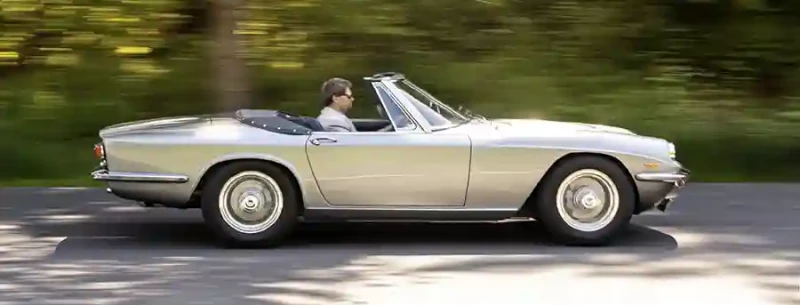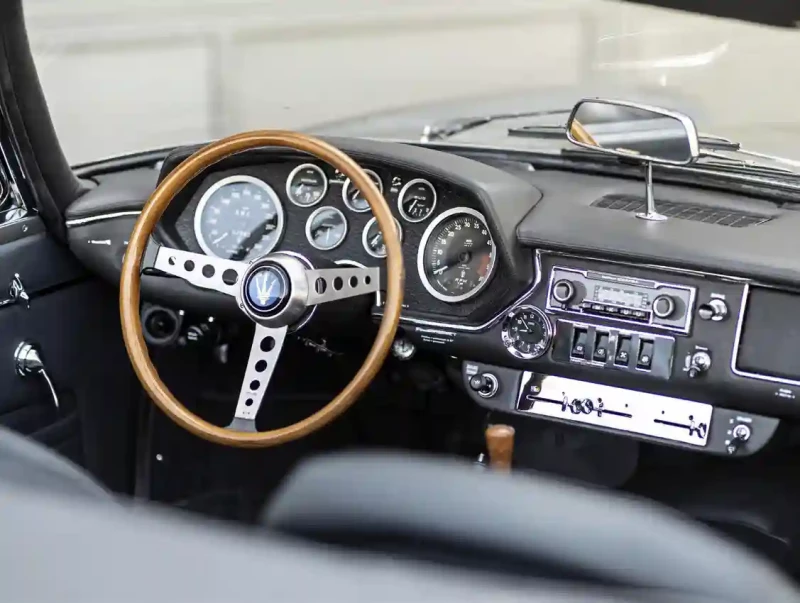1961 Maserati 3500 GT Spyder Vignale vs. 1965 Maserati Mistral 3700 Spyder
The Maserati 3500 GT Spyder Vignale and Mistral Spyder embody Italian grandeur in its most beautiful form – and could hardly be more different.
It is a heavy car yet conveys a sense of weightlessness to its driver. One approaches it with a certain reverence; its elongated silhouette with the lascivious curve over the rear wheel arches makes it appear longer than 4.50 meters. Its dark, almost black Verde Inglese shimmers unfathomably in the sun, as if the rays were breaking in an enchanted mountain lake.

The wide sill acts as a bulwark against the hustle of everyday life, after opening the tiny door and carefully sliding into the driver's seat. The word «into» is deliberately chosen because the open 3500 GT does not convey the claustrophobic confinement of a sports car. The splendor and expanse of its interior are enchanting; one sits above the action, the gaze wandering over the seemingly endless bonnet. Neither does the low-set steering wheel obstruct the view, nor does the narrowly cut seat restrict freedom of movement too much.

A poem of an engine
The stretch of asphalt we're about to merge onto becomes almost secondary. But only almost, until the key, placed to the left of the steering wheel, is turned to the right, the ignition light illuminates, the key is gently pressed into the lock, and the fabulous inline-six cylinder engine comes to life, silky smooth and almost vibration-free.

The long-stroke engine is, by necessity, a direct relative of the engine in the 350S because the planned V8 for the 450S needed more development time. However, for use in the racing car, Chief Engineer Giulio Alfieri had to heavily modify the engine. For instance, he replaced the chain and gear-driven camshaft with a gear cascade and increased the compression but left the bore-stroke ratio untouched. The result is 290 PS in the 350S. Yet, even 220 PS in the 3500 GT are enough to challenge competitors like the 215 PS strong 300 SL Roadster W198. The Spyder presented two years after the coupe clad by Touring effortlessly outstrips it in terms of price: Around 45,000 marks are required for the sculpture on wheels, while the open 300 SL costs 32,500 – the difference is roughly equivalent to the value of a Porsche 356 B 1600 Roadster. Refined taste comes at a price.

This is reflected in the production numbers too. While 1858 units of the W198 300 SL Roadster were built, Maserati produced only 204 GT and 56 GTI Spyder Vignale units. Like a true diva, the Spyder disguises its true production number; some sources mention 245 or only 242 units.
In contrast to the coupe clothed by Touring according to the Superleggera principle with an aluminum body, the Vignale house is responsible for the Spyder. Initially, after Touring had introduced two, according to other sources, three open models with the wheelbase of the 3500 GT. The Vignale version, attributed to designer Giovanni Michelotti, is based on the ten-centimeter shorter chassis, which from 1962 was also used for the 3500 GTI S Coupe, the later Sebring.

As with the also Vignale-produced 3500 GTI S, the Spyder's load-bearing body structure is made of sheet steel. However, for the 1964 presented Mistral Spyder with a body designed by Pietro Frua, Maserati returns to a Touring-like principle and stretches the body over a modified frame with square tubes and rear substructure. While the coupe is made of aluminum, the Mistral Spyder uses a steel-aluminum mixed construction with an aluminum front and a steel rear section, and these body parts are manufactured and assembled by Maggiora in Turin.
Fiery outburst of temperament
Meanwhile, the twelve liters of motor oil in the 3500 GT engine have reached operating temperature. Carefully, the feet reach for the closely spaced pedals. Driving feels like a fiery outburst of temperament: the clutch snaps early, a slight vibration runs through the front, the bass growl mixes with an aggressive snarl, and the robust, elastic long-stroke engine sets the Spyder into an easy trot. Even the first gear changes with the ZF five-speed gearbox are precise, the shift throws are short, the small lever wants to be guided through the gate with a dry insistence. It acts as a baton, coaxing ever new sound nuances from the engine with perfect traction.
Above 3000/min, the twin-spark relinquishes its polished manners, revealing its racing car attitude and developing bear-like forces, only to show its gentle side shortly afterward at 2000/min in fifth. It suits the 3500 GT better; the high seating position and the hurricane at higher speeds encourage a more relaxed driving style. 2500/min suffice for gliding along; only rough irregularities bring slight restlessness into the torsionally stiff structure sitting on a solid tubular frame. The cleanly guided rear solid axle does not reveal itself as a flaw; the conservative approach suits the Maserati, just like the surprisingly direct recirculating ball steering. Additionally, it brakes steadfastly.
On the way to modernity
What follows is almost a culture shock; the Mistral, named after the wind of the same name, seems to sweep away everything archaic like dust from old clothes. It starts with the seating position; with the Mistral, the driver becomes one with the car, sitting lower, enjoying better lateral support, and the axially adjustable steering wheel is well-positioned.
The metamorphosis is all the more impressive as it uses the same chassis components, such as the front suspension from Alford & Alder or the Salisbury rear axle. Even the engine is fundamentally the same, except that it is even longer-stroke and, as a 3.7-liter with Lucas fuel injection – the golden mean of the Mistral engine range – boasts a slightly increased displacement and higher compression.
Nevertheless, it presents itself as Mr. Hyde compared to Dr. Jekyll, 25 extra PS make a world of difference. The Mistral unabashedly inscribes polished Gran Turismo manners into the wind and sounds much more aggressive than its ancestor. It lives the generational shift, extravagantly exceeding the volume. In this comparison, it is the sports car to beat; the brakes and steering respond much more directly. Moreover, it feels lighter, seeming to effortlessly circle around the 3500 GT without losing grip, thus feeling weightless in an entirely different way.
Conclusion
With classic Maseratis, well-maintained technology is crucial – once their Achilles' heel, as opposed to Ferrari, due to the lack of an experienced service network. It took about 4000 hours for the photo-Mistral alone to shine again in its new glory. The effort pays off because experiencing the 3500 GT and Mistral as they left the factory, whether as a coupe or Spyder, is impressive.
DATA AND FACTS
Maserati 3500 GT Spyder Vignale, Year of Manufacture 1961
ENGINE
- Type AM 101, water-cooled inline six-cylinder engine, longitudinally mounted at the front
- Bore x Stroke 86 x 100 mm
- Displacement 3485 cc,
- Max Power output 220 hp at 5500 rpm
- Max Torque 314 Nm at 4000 rpm
- Compression ratio 8.2:1, two valves per combustion chamber, actuated via two overhead chain-driven camshafts and rocker arms, seven-bearing crankshaft, aluminum engine block and cylinder head, three horizontal twin-choke Weber 42DCOE8 carburetors, dual ignition, pressure-feed lubrication, 12-liter oil capacity
POWER TRANSMISSION
Single dry-plate clutch, five-speed manual gearbox ZF S5/17 (four-speed gearbox until 1960), limited-slip differential, rear-wheel drive
BODY AND CHASSIS
Two-seater roadster body made of steel with doors and hoods of aluminum on a tubular frame, front independent suspension with double wishbones, coil springs, rear live axle on leaf springs and trailing arms, front and rear stabilizer bars and telescopic shock absorbers, servo-assisted hydraulic brakes (front discs, rear drums), ball-type steering, wheels 6.50 x 16, tires 185 R 16
DIMENSIONS AND WEIGHTS
Wheelbase 2500 mm, Track front/rear 1390/1360 mm, Length x Width x Height 4500 x 1700 x 1300 mm, Weight 1440 kg, Tank capacity 75 liters
PERFORMANCE AND FUEL CONSUMPTION
Top speed 215 km/h, Acceleration 0 to 100 km/h in 10 s, Fuel consumption 13–18 l/100 km
PRODUCTION AND QUANTITY
1959–1964, 204 GT and 56 GTI Spyder Vignale


